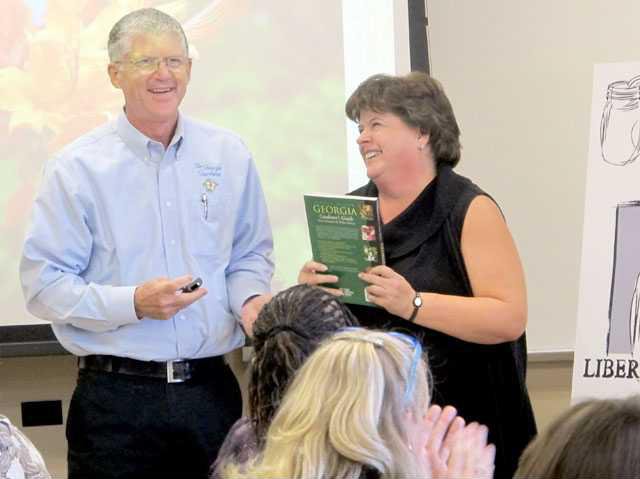Walter Reeves, who is best known as the Georgia Gardener, served as the guest speaker Thursday at the Liberty County Chamber of Commerce’s Progress through People luncheon at the Liberty County Performing Arts Center.
Reeves, who retired after 30 years with the University of Georgia Cooperative Extension, got his start on a small family farm in Fayette County, southwest of Atlanta. Though he earned a degree in chemistry, he said he got most of his gardening and landscaping skills while working on the farm and through a variety of 4-H projects.
Keep Liberty Beautiful Director Sara Swida introduced Reeves to Chamber members and guests. She joked that she was a Walter Reeves “groupie” who for years has depended on Reeves’ television and radio shows, website and books for gardening information. Swida said she was wondering how she would introduce someone as well known as the Georgia Gardener then Reeves told her to introduce him as a “nice man who knows a lot about gardening.”
Before he began his presentation on native Georgia plants, Reeves first presented one of his nine books about gardening and landscaping to Swida.
“I’ve never been to Hinesville in my life,” said Reeves, admitting he has been to Savannah and other coastal towns several times but not to Liberty County. “This place is beautiful, and there’s not another place in Georgia where native plants are so appreciated as they are here.”
Throughout his presentation, Reeves would pause or say something off the cuff. He said when he gets worked up about gardening, he becomes a little preachy. He joked that he even had a song he could sing about gardening called, “There’s power in the mud.”
He told guests that native plants are important in that they provide a sense of place. This is where that plant came from and where it belongs.
He began by distinguishing white oaks from red oaks then moved the discussion to talking about pecans.
“May I interrupt you for just a moment while you’re talking about that?” asked George Holtzman, owner of Coldwell Banker and Holtzman Realty. “Why is it so hard to get young pecan trees to grow?”
Reeves responded that pecan trees require deep tap roots in order to establish themselves. He said some pecan farmers plant their pecan seedlings with an auger that drills deep enough into the soil to allow the roots room to expand and support the young tree’s growth.
Reeves continued talking about native trees, including maples, dogwoods, red buckeyes, redbuds, serviceberry and evergreens. Jeff Ricketson then asked if Reeves knew whether there was a state-wide blight killing dogwood trees. Reeves said there has been some areas in the state with dogwood blight but said there was no real statewide problem. He added blight problems were sometimes weather-related to a specific region.
He turned his attention to shrubs then asked guests to tell him what is Georgia’s state flower and was correctly told it was the Cherokee rose. He then told them the state’s flower is not native to our state but imported from China. To compensate for this error, he said the state legislature established the wild azalea as the state’s official wildflower. He then paused to talk about the Haupen holly, which he said was sometimes used by Native Americans to make a special tea.
“There’s enough caffeine in that tea to knock a horse on its behind,” he laughed. “It will make you see things.”
Reeves finished off his discussion on native plants by talking about native fruit plants and vines. No matter what plant he discussed, his presentation included several colorful slides of that plant as it grows in the wild or found near a home or church. His presentation ended with a close-up of some wisteria growing in his own yard.
He concluded with a brief discussion of native Georgia wildlife, including the opossum. Immediately, a full-frame picture of Reeves holding a opossum by the tail became the next slide. The room filled with laughter.
Georgia, how does your garden grow?
Master gardener speaks at chamber lunch


Sign up for our e-newsletters